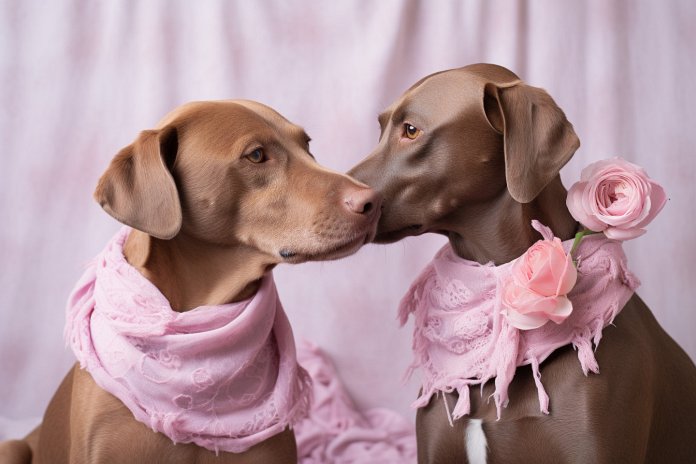
You may have heard about dogs detecting cancer in people before, but did you know that they can also sniff out cancer in other dogs? Dogs have incredibly powerful noses, with about 25 times more smell receptors than humans, allowing them to detect changes in a dog’s body composition and cancer cells. Their olfactory cortex, which is much larger than a human’s, enables them to sniff out cancer cells in other dogs. In this article, we will explore the signs that your dog might be sniffing out cancer in another dog, how you can train your dog to be a cancer-detection dog, and more information on the impressive power of a dog’s nose.
Signs Your Dog is Sniffing Out Cancer in Another Dog
Similar to sniffing out illness or cancer in humans, dogs exhibit certain signs when they are detecting cancer in another dog. One of the key signs is that your dog will spend a significant amount of time, attention, and affection on the dog with cancer. They may nuzzle the area where they detect the cancerous scent. Your dog might also become unusually attentive, anxious, or protective of the dog with cancer, displaying behaviors such as jumping, nudging, howling, barking, and other changes in behavior.
Body Language
Look out for these body language cues if you suspect your dog is trying to alert you to another dog’s health:
- Growling
- Alertness
- Barking
- Jumping up
- Sniffing
- Tail tucking
- Licking
- Ears up
Other Signs
Other signs that your dog might be sniffing out cancer in another dog include incessantly nudging or nuzzling the other dog, showing an obsession with a certain area, and not leaving the side of the dog with cancer.
History of Dogs Sniffing Out Cancer
While dogs sniffing out cancer in other dogs is less common, using dogs to detect illness and cancer in humans is not a new concept. The first documented case of a dog detecting an illness was in 1989 when a dog alerted its owner to a cancerous mole on her leg. Since then, studies have shown that dogs have a 99 percent accuracy rate in predicting lung cancer and other types of cancers. Researchers have trained dogs to detect various cancers, including cervical, bladder, skin, lung, and ovarian cancer.
The Science Behind Dogs Smelling Cancer
Cancerous cells release different metabolic waste products than healthy cells, and dogs can detect this difference. Dogs can even detect cancer in its earliest stages due to their incredible sense of smell. Similar to detecting cancer in humans, dogs can detect the change in cell smell in other dogs.
Training Your Dog to Sniff Out Cancer
If you believe your dog has an exceptional sense of smell, you can consider training them to detect cancer. Dogs can be trained to differentiate between the scent of healthy cells and cancer cells in both humans and other animals. Training involves presenting the dog with hundreds of samples and using a play and reward system. Enrolling your dog in a certified program is recommended for proper training.
Conclusion
Dogs have an extraordinary ability to sniff out cancer in both humans and other dogs. By paying attention to the signs and body language cues, you can determine if your dog is detecting cancer in another dog. If you want to train your dog to detect cancer, consider a certified training program that utilizes a play and reward system. With their powerful noses, dogs can contribute to early cancer detection and potentially save lives.
“Unlocking the Hidden Powers of Your Dog’s Nose: Sniffing Out Cancer in Other Dogs”

Tips & Things to Know
1️⃣ If your dog is exhibiting unusual behavior towards another dog, such as excessive attention, nuzzling, or protective behavior, it could be a sign that they are sniffing out cancer in that dog. Pay attention to these signs and consider seeking medical attention for the other dog.
2️⃣ Look out for specific body language cues in your dog that may indicate they are trying to alert you to another dog’s health. These cues can include growling, barking, jumping up, sniffing, tail tucking, licking, and ears up. Understanding your dog’s body language can help you identify potential health concerns in other dogs.
3️⃣ If you believe your dog has an exceptional sense of smell and may be able to detect cancer, consider getting them trained to sniff out cancer cells. Proper training involves introducing your dog to various scents and using a reward-based system to reinforce their ability to identify cancerous scents. Enrolling your dog in a certified training program can ensure they receive the proper training.
Frequently Asked Questions, Answered ✅
1. How can dogs detect cancer in both people and other dogs?
– Dogs have a much more powerful sense of smell than humans, with about 25 times more smell receptors. They can sniff out the changes in certain cells that occur when a person or dog develops cancer.
2. What are some signs that a dog is sniffing out cancer in another dog?
– One major sign is that the dog will spend a lot of time, attention, and affection on the dog with cancer. They may nuzzle the area where the cancer is located. Dogs may also show strange behaviors like being overly attentive, anxious, or protective of the affected dog.
3. What are some body language cues that indicate a dog is trying to alert you to another dog’s health?
– Some body language cues to look out for include growling, being alert, barking, jumping up, sniffing, tail tucking, licking, and ears being up.
4. Why are dogs able to detect cancer in its earliest stages?
– Cancerous cells release a different metabolic waste product than healthy cells. Dogs with their exceptional sense of smell can detect this difference, even in the early stages of cancer.
5. How can you train your dog to sniff out cancer?
– Dogs can be trained to detect the scent of cancerous cells through bodily fluids or breath. They need to be presented with hundreds of samples to learn the specific scent. Enrolling them in a certified program that uses a play and reward system is recommended for proper training.